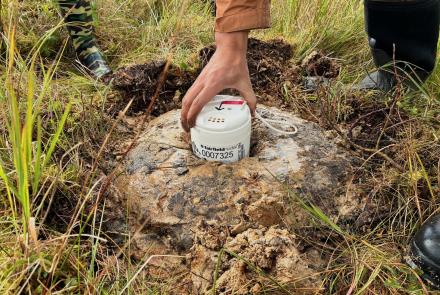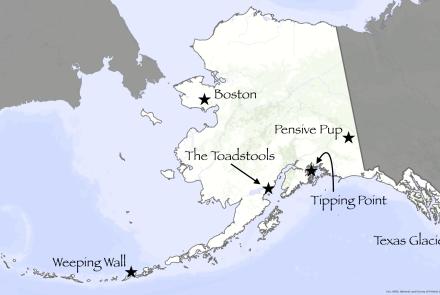Detecting Permafrost 'til the Cows Come Home
Ice-rich permafrost is a builder's bane. Erect a warm fast-food restaurant on ice-rich ground, and you'll end up with the Leaning Tower of Pizza...
Even without bad jokes, permafrost can make for a bad situation. It's everywhere on the North Slope, but is spotty between the Brooks and Chugach mountain ranges. At any site there, engineers may have to deal with permanently frozen ground. Detecting whether it's there is a matter of real importance, because it's far more expensive to build structures designed to keep permafrost from melting--or to rebuild one damaged by melting's effects.
Digging or drilling holes to take soil samples is the surest way to test for permafrost, but that too is expensive. Northern researchers have been hunting for cheaper ways to find permafrost, or at least lessen the number of necessary drill holes. Among these are gravity, seismic, and electrical methods.
The hunt seems to call for straightforward research, progressing until the problem is solved. But investigative science, like the plots of detective novels, is often punctuated by the unexpected.
In this case, a promising approach being investigated for detecting permafrost depends on changes in the electrical properties of soil caused by the presence of frozen water. Some devices that detect these changes are small enough to be carried by one person.
Field testing is the approved way to tell which technique and which device works best. Thus, not too long ago, a group of researchers at the Geophysical Institute built a lump of artificial permafrost--appropriately enough, in a field at the University of Alaska research farm.
To provide a valid test for techniques and equipment, and realistic training for operators, they excavated a pit, measured it, filled it part way with water, and let winter do the freezing. Then they buried it with the excavated soil and tamped the whole thing down. This gave them controlled variables for their experiments; they had a mass of ground ice of known dimensions, at a known depth, and of known resistivity.
The pit lay in a seldom-used corner of the university farm. The location provided a natural landscape and the realism of nearby powerlines and passing vehicles to challenge the sensitivity of detectors. It was also conveniently close to the institute, and in a fenced area protected from passersby.
It was a fine test medium for their purposes, and worked well until warmer weather threatened to melt the artificial permafrost. To prevent that, the team removed the thawed topsoil and insulated their ice mass with layers of Styrofoam board. Then they shoveled soil and dried peat back over the insulation and went away for the evening, not realizing they'd had an audience.
The farm's herd of beef cattle had been moved to an adjoining pasture, and the cattle were apparently fascinated by the scientists' doings.
Usually these cattle are among the most sedate and well-behaved of animals. They stay calm in the face of a tourist's camera or agricultural technician's prodding. They move slowly, stay where they're put, do what they're told. Usually.
This time, the researchers returned to find what looked like the leftovers from a wild bovine party. The fence between the pastures was wrecked, and shards of plastic foam were scattered everywhere. The permafrost lump lay exposed to the sun, sheltered only by a few shreds of moss and tattered crumbs of plastic. Cattle wandered here and there, occasionally kicking at a foam-board remainder large enough to offer entertainment.
"I've never seen anything like it," one of the researchers said. "I couldn't tell if they like the squeak or the feeling or what, but they just had to put their hooves through that plastic. And punt it around. They were like a bunch of kids---big hairy kids."
Despite the setback, research is continuing on devices to detect permafrost inexpensively. But a new item has entered the protocols of permafrost research: beware of bored cattle.



